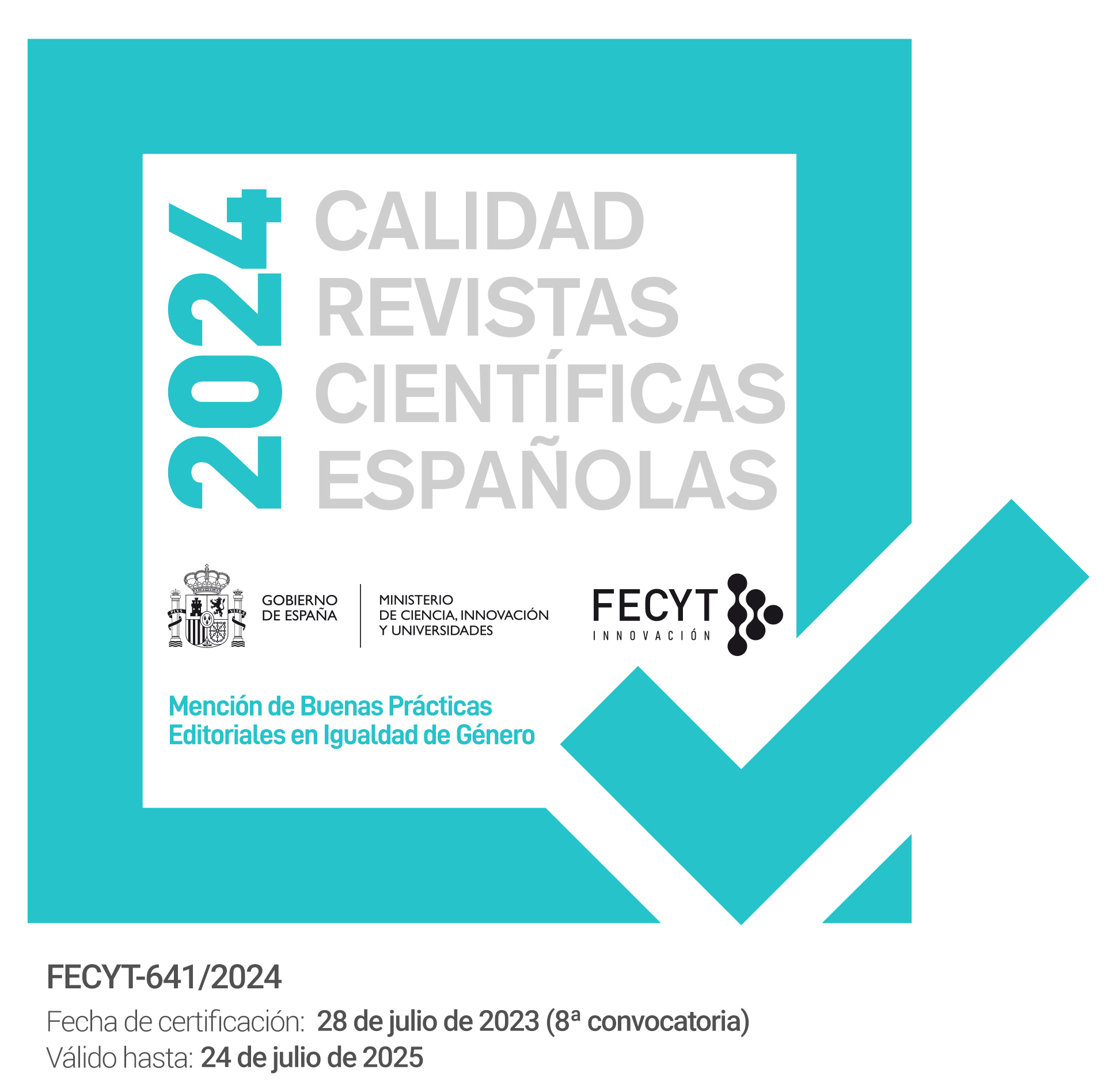The low periphery of double object constructions in English and Spanish
DOI:
https://doi.org/10.12795/PH.2009.v23.i02.04Keywords:
double object constructions, topic, focus, word order, minimalismAbstract
In this paper I will explore the possibility that double object con- structions (DOCs) project a low periphery with specific dedicated categories for focus and topics. Languages such as Spanish are shown to allow for the projection of these discourse-related catego- ries in DOCs, whereas languages such as English do not. This will account for the parametric differences in word order identified in both languages.
Downloads
References
Arnold, J. & Wasow, T. (2003) “Post-verbal Constituent Ordering in English”. In G. Rohdenburg & B. Mondorf (eds.) Determinants of Grammatical Varia-tion in English, 119-154. Berlin: Mouton de Gruyter.
Behaghel, O. (1930) Von deutscher Wortstellung [On German word order], Zeitschrift fur Deutschkunde, 44, 81-9.
Belletti, A & U. Shlonsky (1995) “The Order of Verbal Complements: A Compara-tive Study”, Natural Language and Linguistic Theory 13, 489-526.
Belletti, A. (2004) “Aspects of the Low IP Area”. In L. Rizzi (ed.) The Structure of CP and IP: The Cartography of Syntactic Structures, Volumen 2. Oxford: Oxford University Press. 16-51.
Belletti, A. (2005) “Extended doubling and the VP periphery”, Probus 17, 1-35.
Beninca’, P. & C. Poletto (2004) “Topic, Focus, and V2: Defining the CP Sublay-ers”. In L. Rizzi (ed.) The Structure of CP and IP – The Cartography of Syntactic Structures, Vol. 2. Oxford University Press: New York, 52-75.
Brunetti, L. (2003) “Is there any Difference between Contrastive Focus and Infor-mation Focus?” In M. Weisgerber (ed.), Proceedings of the Sinn und Be-deutung SuB7, Universitat Konstanz, Germany, 53-69.
Camacho, V. (2006) La Arquitectura de la Gramática: Los Clíticos Pronominales Románicos y Eslavos. Sevilla: Servicio de Publicaciones de la Universidad de Sevilla.
Chomsky, N. (2001) “Derivation by phase”. In: M. Kenstowicz (ed.) Ken Hale: a life in language. Cambridge, MA: MIT Press. 1-52.
Chomsky, N. (2006) “Approaching UG from below”, manuscript, MIT.
Chomsky, N. (2008) “On phases”. In: R. Freidin, C. Otero & M.L. Zubizarreta (eds.), Foundational Issues in Linguistic Theory. Cambridge, MA: MIT Press. 133-166.
Cinque, G. (1999) Adverbs and Functional Heads. Oxford: Oxford University Press.
Costa, J. (2000) “Focus in situ: Evidence from Portuguese”. Probus 12 (2), 187-228.
Costa, J. & M.C. Figueiredo (2006) “On the (in)dependence relation between syn-tax and pragmatics”. In: V. Molnár & S. Winkler (eds.), The Architecture of Focus. Berlin/New York: Mouton de Gruyter. 83-104.
Demonte, V. (1995) “Dative alternation in Spanish”, Probus 7, 5-30.
Demonte, V. & O. Fernández Soriano (2009) “Force and Finiteness in the Spanish Complementizer System”, Probus (to appear).
Diesing, M. (1997) “Yiddish VP order and the typology of object movement in Germanic”, Natural Language and Linguistic Theory 15, 369-427.
Durrleman-Tame, S. (2005) “Notes on the Left periphery in Jamaican Creole”, GG@G (Generative Grammar in Geneva) 4, 113-157.
É. Kiss, K. (1995) Discourse Configurational Languages. Oxford Studies in Com-parative Syntax. New York / Oxford: Oxford University Press.
É. Kiss, K. (1998) “Identificational Focus versus Information Focus”, Language 74, 245-273.
É. Kiss, K. (2002) The Syntax of Hungarian. Cambridge: CUP.
É. Kiss, K. (2008) “Free word order, (non)configurationality, and phases”, Linguis-tic Inquiry 39 (3), 441-475.
Etxepare, R. & M. Uribe-Etxebarria (2008) “The interfaces of focus in Spanish”, paper presented at the Mediterranean Syntax Meeting II, Boğaziçi Univer-sity, Istambul.
Haider, H. (2004) “Pre- and postverbal adverbials in OV and VO”, Lingua 114, 779-807.
Hernanz, M.L. (2007) “From polarity to modality: Some (a)symmetries between bien and sí in Spanish”. In: L. Eguren & O. Fernández Soriano (eds.). Coreference, Modality, and Focus, Amsterdam/Philadephia: John Benja-mins. 133-170.
Hinterhölzl, R. (2006) Scrambling, Remnant Movement, and Restructuring in West Germanic. Oxford: OUP.
İşsever, S. (2003) “Information Structure in Turkish: The Word Order-Prosody In-terface”, Lingua 113, 1025-1053.
Jackendoff, R. (1990) “On Larson's treatment of the double object construction”, Linguistic Inquiry 21, 427-456.
Jayaseelan, K. (2001) “IP-Internal Topic and Focus Phrases”, Studia Linguistica 55, 39-75.
Jiménez, Á. (2000) “Categorías Funcionales Mínimas”, Actas del IV Congreso de Lingüística General. Universidad de Cádiz. 1515-1523.
Jiménez, Á (2005). “A Minimalist Approach to Topicalisation and Focalisation”. In: F. Garrudo & J. Comesaña (eds.) Estudios de Filología Inglesa en Honor de Antonio Garnica. Sevilla: Servicio de Publicaciones de la Uni-versidad de Sevilla. 269-290.
Jiménez, Á. (2008) “A discourse/agreement-based approach to peripheries”, paper presented at the Mediterranean Syntax Meeting II, Boğaziçi University, Is-tambul.
Kayne, R. (1994) The Antisymmetry of Syntax. Cambridge, MA: The MIT Press.
Larson, R. (1988) “On the Double Object Construction”, Linguistic Inquiry 19: 335-391.
Larson, R. (1990) “Double Objects Revisited: Reply to Jackendoff”, Linguistic In-quiry 21: 589-632.
Linden, E. van der & P. Sleeman (2007) “Clitic Dislocation: Evidence for a low Topic position”. In: B. Los & M. van Koppen (eds.), Linguistics in the Netherlands. 173–186.
Miyagawa, S. (2005) “On the EPP”. In: N. Richards & M. McGinnis (eds.) Per-spectives on Phases. Cambridge, MA: MIT Press. 201-236.
Ndayiragije, J. (1999) “Checking. Economy”, Linguistic Inquiry 30 (3), 399-444.
Ojea, A. (1994) “Adverbios y categorías funcionales en español”, Revista Española de Lingüística 24 (2), 393-416.
Ordoñez, F. (1998) “Post-Verbal Asymmetries in Spanish”, Natural Language & Linguistic Theory 16, 313-346.
Pollock, J.-Y. (1989) “Verb movement, Universal Grammar and the Structure of IP”, Linguistic Inquiry 20, 365-424.
Quirk, R., S. Greenbaum, G. Leech & J. Svartvik (1985) A Comprehensive Gram-mar of the English Language. Londres/Nueva York: Longman.
Radford, A. (2007) “Split projections, percolation, syncretism and interrogative auxiliary inversion”. In: A. Radford (ed.) Martin Atkinson – The Minimal-ist Muse, Essex Research Reports in Linguistics 53, 157-192.
Radford, A. (2009) Analysing English Sentences. Cambridge: CUP.
Rizzi, L. (1997) “The Fine Structure of the Left Periphery”. In: L. Haegeman (ed.), Elements of Grammar. Kluwer, Dordrecht, 281-337.
Rizzi, L. (2004) The Structure of CP and IP: the Cartography of Syntactic Struc-tures. New York: Oxford University Press, 1-75.
Rooryck, J. (1992) “Romance Enclitic Ordering and Universal Grammar”, Linguis-tic Review 9: 219-250.
Ross, J. R . (1967) Constraints on Variables in Syntax. PhD diss., MIT.
Rouveret, A. (2002) “How are resumptive pronouns linked to the periphery?” Lin-guistic Variation Yearbook, volume 2, 123-184. Amsterdam: John Benja-mins.
Samek-Lodovici, V. (2005) “Prosody-Syntax Interaction in the Expression of Fo-cus”, Natural Language & Linguistic Theory 23, 687-755.
Uriagereka, J. (1995) “An F-position in Western Romance”. In: K. É. Kiss (ed.), Discourse Configurational Languages, 153–175. Oxford: Oxford Univer-sity Press.
Valmala, V. (2008) “Topic, focus and floating quantification”, paper presented at the Mediterranean Syntax Meeting II, Boğaziçi University, Istanbul.
Villalba, X. (1999) “Right Dislocation is not right dislocation”. In: O. Fullana, F. Roca (eds.). Studies on the Syntax of Central Romance Languages. Girona: Universidad de Girona. 227-241
Xu, L. (2004) “Manifestation of informational focus”, Lingua 114, 277-299.
Zubizarreta, M.L. (1998) Prosody, Focus, and Word Order. Cambridge, MA: MIT Press.
Zubizarreta, M.L. (1999) “Las funciones informativa: Tema y foco”. In: I. Bosque & V. Demonte (eds.). Gramática Descriptiva de la Lengua Española. Ma-drid: Espasa. 4215-4244.
Downloads
Published
How to Cite
Issue
Section
License
The printed and electronic editions of this Journal are edited by the University of Seville Editorial, and the source must be cited in any partial or total reproduction.
Unless otherwise indicated, all the contents of the electronic edition are distributed under a license of use and distribution “Attribution-NonCommercial-NoDerivatives 4.0 International” . You can view the informative version and the legal text of the license here. This fact must be expressly stated in this way when necessary.
Authors who publish in this journal accept the following conditions:
- The author/s retain copyright and grant the journal the first publication right, and accept it to be distributed with the Creative Commons By NC ND 4.0 licence, which allows third parties to use what is published whenever they mention the authorship of the work and the first publication in this journal and whenever they do not make commercial use and reuse it in the same way.
- Authors can make other independent and additional contractual agreements for the non-exclusive distribution of the article published in this journal (e.g., include it in an institutional repository or publish it in a book) provided they clearly indicate that the work was published for the first time in this journal.
Authors are allowed and recommended, once the article has been published in the journal Philologia Hispalensis (online version), to download the corresponding PDF and disseminate it online (ResearchGate, Academia.edu, etc.) as it may lead to productive scientific exchanges and to a greater and faster dissemination of published work (see The Effect of Open Access).
- Abstract 116
- PDF (Español (España)) 65







